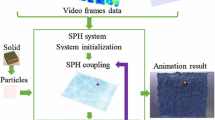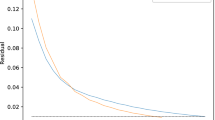Abstract
This paper presents a fast smoothed particle hydro-dynamics (SPH) simulation approach for gaseous fluids. Unlike previous SPH gas simulators, which solve the transparent air flow in a fixed simulation domain, the proposed approach directly solves the visible gas without involving the transparent air. By compensating the density and force calculation for the visible gas particles, we completely avoid the need of computational cost on ambient air particles in previous approaches. This allows the computational resources to be exclusively focused on the visible gas, leading to significant performance improvement of SPH gas simulation. The proposed approach is at least ten times faster than the standard SPH gas simulation strategy and is able to reduce the total particle number by 25–400 times in large open scenes. The proposed approach also enables fast SPH simulation of complex scenes involving liquid–gas transition, such as boiling and evaporation. A particle splitting and merging scheme is proposed to handle the degraded resolution in liquid–gas phase transition. Various examples are provided to demonstrate the effectiveness and efficiency of the proposed approach.







Similar content being viewed by others
References
Adams, B., Pauly, M., Keiser, R., Guibas, L.J.: Adaptively sampled particle fluids. In: ACM Transactions on Graphics (TOG), vol. 26, p. 48. ACM (2007)
Angelidis, A., Neyret, F., Singh, K., Nowrouzezahrai, D.: A controllable, fast and stable basis for vortex based smoke simulation. In: Proceedings of the 2006 ACM SIGGRAPH/Eurographics symposium on computer animation, SCA ’06, pp. 25–32. Eurographics Association, Aire-la-Ville, Switzerland, Switzerland (2006). http://dl.acm.org/citation.cfm?id=1218064.1218068
Bender, J., Erleben, K., Teschner, M., et al.: Boundary handling and adaptive time-stepping for pcisph. In: Workshop on virtual reality interaction and physical simulation VRIPHYS (2010)
Boyd, L., Bridson, R.: Multiflip for energetic two-phase fluid simulation. ACM Trans. Graph. 31(2), 16 (2012)
Brochu, T., Keeler, T., Bridson, R.: Linear-time smoke animation with vortex sheet meshes. In: Lee, J., Kry, P.G. (eds.) Symposium on Computer Animation, pp. 87–95. Eurographics Association (2012)
Cleary, P.W.: Modelling confined multi-material heat and mass flows using SPH. Appl. Math. Model. 22(12), 981–993 (1998). doi:10.1016/S0307-904X(98)10031-8
Colagrossi, A., Landrini, M.: Numerical simulation of interfacial flows by smoothed particle hydrodynamics. J. Comput. Phys. 191(2), 448–475 (2003)
Desbrun, M., Cani, M.P.: Space-time adaptive simulation of highly deformable substances. Rapport de recherche RR-3829, INRIA (1999). http://hal.inria.fr/inria-00072829
Feldman, J., Bonet, J.: Dynamic refinement and boundary contact forces in sph with applications in fluid flow problems. Int. J. Numer. Methods Eng. 72(3), 295–324 (2007)
Gao, Y., Li, C.F., Hu, S.M., Barsky, B.A.: Simulating gaseous fluids with low and high speeds. Comput. Graph. Forum 28(7), 1845–1852 (2009). doi:10.1111/j.1467-8659.2009.01562.x
Gao, Y., Li, C.F., Ren, B., Hu, S.M.: View-dependent multiscale fluid simulation. Vis. Comput. Graph. IEEE Trans. 19(2), 178–188 (2013). doi:10.1109/TVCG.2012.117
Gerszewski, D., Bargteil, A.W.: Physics-based animation of large-scale splashing liquids. ACM Trans. Graph. 32(6), 185:1–185:6 (2013)
Hong, W., House, D.H., Keyser, J.: Adaptive particles for incompressible fluid simulation. Vis. Comput. 24(7–9), 535–543 (2008)
Ihmsen, M., Cornelis, J., Solenthaler, B., Horvath, C., Teschner, M.: Implicit incompressible sph. IEEE Trans. Vis. Comput. Graph. 20(3), 426–435 (2014). doi:10.1109/TVCG.2013.105
Keiser, R., Adams, B., Dutre, P., Guibas, L.J., Pauly, M.: Multiresolution particle-based fluids. ETH Zurich, NAkinci (2006)
Kim, S.T., Hong, J.M.: Visual simulation of turbulent fluids using mls interpolation profiles. Vis. Comput. 29(12), 1293–1302 (2013)
Li, X., Liu, L., Wu, W., Liu, X., Wu, E.: Dynamic bfecc characteristic mapping method for fluid simulations. Vis. Comput. 30(6–8), 787–796 (2014). doi:10.1007/s00371-014-0969-7
Macklin, M., Müller, M., Chentanez, N., Kim, T.Y.: Unified particle physics for real-time applications. ACM Trans. Graph. (TOG) 33(4), 104 (2014)
Monaghan, J.J.: Simulating free surface flows with sph. J. Comput. Phys. 110(2), 399–406 (1994)
Müller, M., Charypar, D., Gross, M.: Particle-based fluid simulation for interactive applications. In: Proceedings of the 2003 ACM SIGGRAPH/Eurographics symposium on computer animation, SCA ’03, pp. 154–159. Eurographics Association, Aire-la-Ville, Switzerland, Switzerland (2003). http://dl.acm.org/citation.cfm?id=846276.846298
Müller, M., Schirm, S., Teschner, M., Heidelberger, B., Gross, M.: Interaction of fluids with deformable solids: research articles. Comput. Animat. Virtual Worlds 15(3–4), 159–171 (2004). doi:10.1002/cav.v15:3/4
Müller M., Solenthaler, B., Keiser, R., Gross, M.: Particle-based fluid-fluid interaction. In: Proceedings of the 2005 ACM SIGGRAPH/Eurographics symposium on computer animation, SCA ’05, pp. 237–244. ACM, New York, NY, USA (2005). doi:10.1145/1073368.1073402
Orthmann, J., Kolb, A.: Temporal blending for adaptive sph. In: Computer Graphics Forum, vol. 31, pp. 2436–2449. Wiley Online Library (2012)
Pfaff, T., Thuerey, N., Gross, M.: Lagrangian vortex sheets for animating fluids. ACM Trans. Graph. 31(4), 112:1–112:8 (2012). doi:10.1145/2185520.2185608
Schechter, H., Bridson, R.: Ghost sph for animating water. ACM Trans. Graph. (TOG) 31(4), 61 (2012)
Solenthaler, B., Gross, M.: Two-scale particle simulation. In: ACM Transactions on Graphics (TOG), vol. 30, p. 81. ACM (2011)
Solenthaler, B., Pajarola, R.: Density contrast sph interfaces. In: Proceedings of the 2008 ACM SIGGRAPH/Eurographics symposium on computer animation, SCA ’08, pp. 211–218. Eurographics Association, Aire-la-Ville, Switzerland, Switzerland (2008). http://dl.acm.org/citation.cfm?id=1632592.1632623
Yan, H., Wang, Z., He, J., Chen, X., Wang, C., Peng, Q.: Real-time fluid simulation with adaptive sph. Comput. Animat. Virtual Worlds 20(2–3), 417–426 (2009)
Zhu, B., Yang, X., Fan, Y.: Creating and preserving vortical details in sph fluid. Comput. Graph. Forum 29(7), 2207–2214 (2010)
Acknowledgments
The authors would like to thank the anonymous reviewers for their constructive comments, and Prof. Jianjun Zhang and Prof. Jian Chang for their suggestions. This work is supported by the National Basic Research Project of China (Project Number 2011CB302205), the Natural Science Foundation of China (Project Number 61120106007) and the National High Technology Research and Development Program of China (Project Number 2012AA011503). The authors would also like to acknowledge the financial support provided by the National Science Foundation (NSF IIS-1320644) and UNC Carolina Development Foundation, and Sêr Cymru National Research Network in Advanced Engineering and Materials.
Author information
Authors and Affiliations
Corresponding author
Electronic supplementary material
Below is the link to the electronic supplementary material.
Appendix A: Derivation of Eqs. (7–8)
Appendix A: Derivation of Eqs. (7–8)
This appendix shows the detailed derivations of Eqs. (7) and (8). Since densities in adjacent particles are assumed to change gradually in the gas simulations, we can further consider that for a particle \(i\), the densities of its neighboring particles \(\rho _{i,j}\) are corrected with the same proportion as itself and in a similar form as Eq. (6):
Here we want to determine the value of the scalar \(V\), which for a given particle \(i\) does not vary with adjacent particle \(j\). Using the form in Eq. (27), Eq. (4) can be rewritten as
Utilizing \(V_0\) in Eq. (5), the above equation can be further rewritten as
Note that it has been assumed in the first place that the final correction form should be in the form of Eq. (27), which is equivalent to requiring \(m_k=V\rho _i\). Comparing this with Eq. (29), the following equation can be obtained:
Solving Eq. (30) yields
Substituting Eq. (31) into Eqs. (27) and (29) leads to Eqs. (7–8).
Rights and permissions
About this article
Cite this article
Ren, B., Yan, X., Yang, T. et al. Fast SPH simulation for gaseous fluids. Vis Comput 32, 523–534 (2016). https://doi.org/10.1007/s00371-015-1086-y
Published:
Issue Date:
DOI: https://doi.org/10.1007/s00371-015-1086-y




